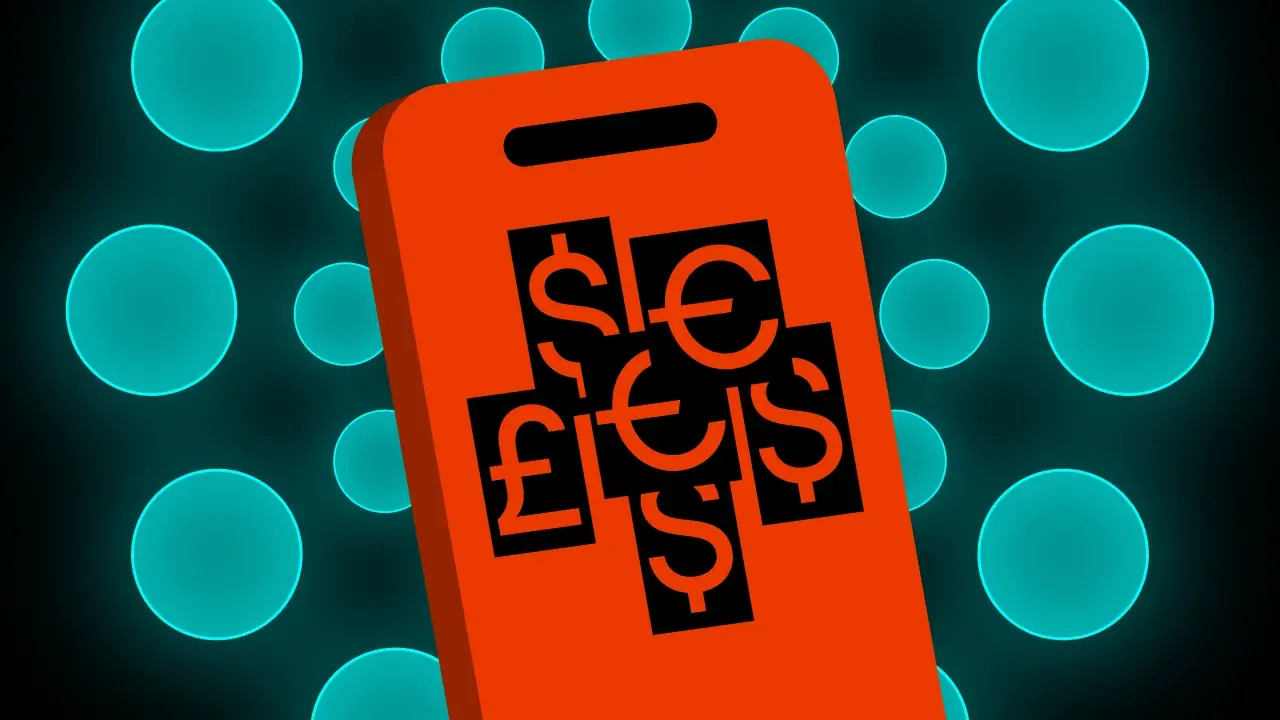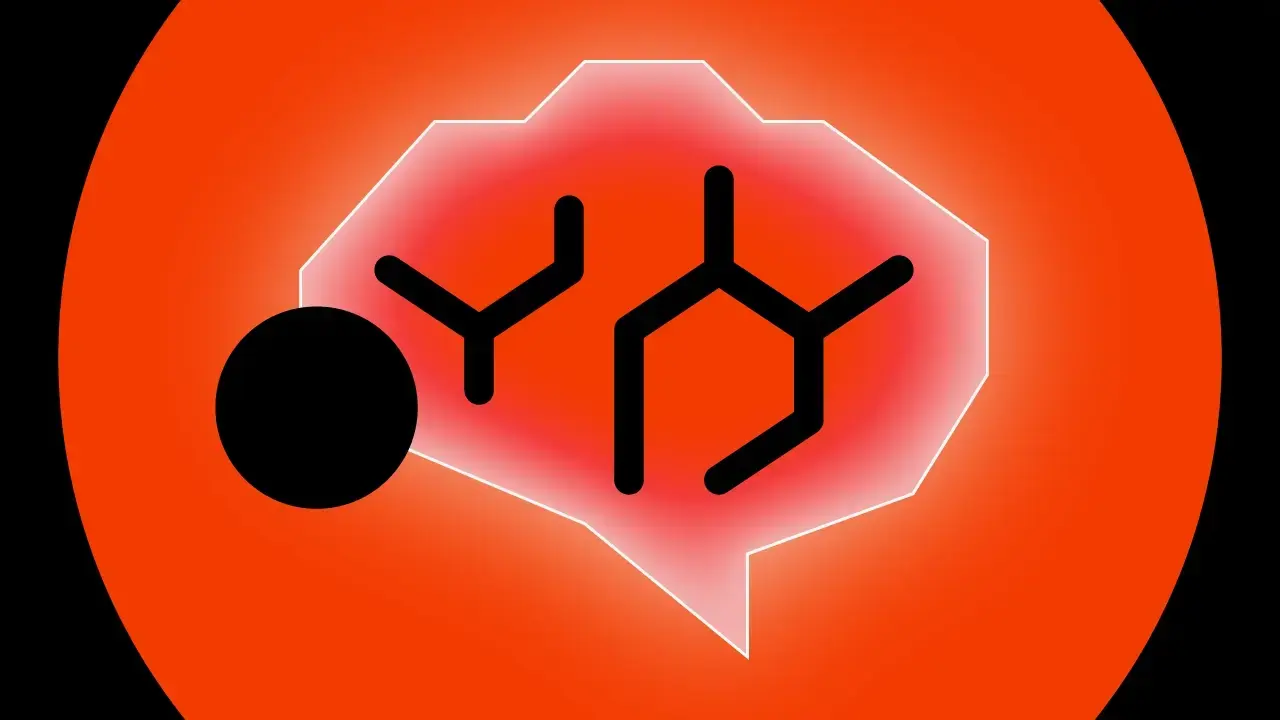Mobile app development costs in 2025

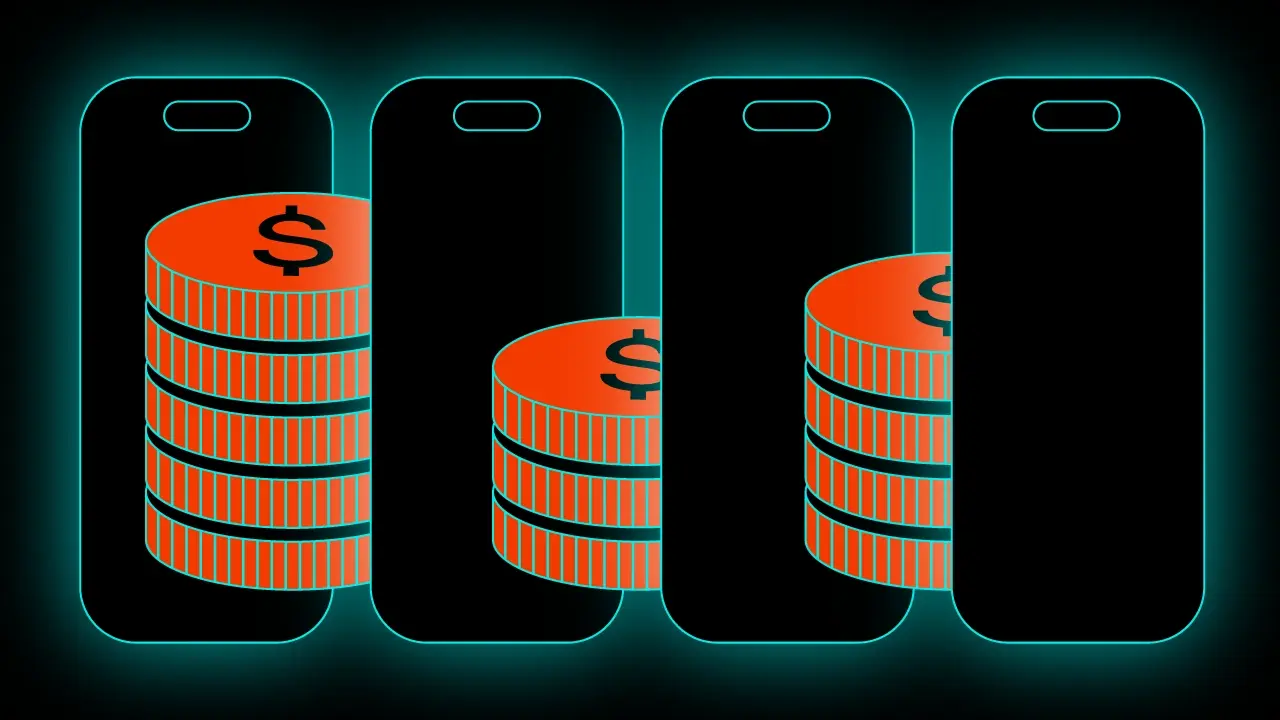
What can we expect from the mobile app market in 2025? The answer is quite straightforward – more of the same as last year. By that, we mean a continuation of dynamic growth. Data from the State of Mobile 2025 report suggests that global revenue from in-app purchases (IAP) on iOS and Google Play platforms has reached €137 billion (150 billion USD), marking a 13% increase compared to the previous year. The growth trajectory is particularly notable in the non-gaming app segment, which saw an impressive 23% year-on-year surge, although gaming apps also showed signs of recovery, with revenues rising by 4%. Since mobile apps remain such a hot topic, let’s look at the costs. In this blog post, we’ll explore what factors contribute to them and what strategies can be used to lower the final price.
Table of contents
Main mobile app development cost factors
Let’s start with the basics. The mobile app development cost hinges on a straightforward formula: (Features × Development time) × Hourly rate. Simple, right? Well, not quite. While this gives a starting point, the real story lies in the variables. Some apps need only a few basic features, while others demand intricate systems like payment gateways or AI tools. Development time can stretch from weeks to months, and hourly rates swing wildly depending on where your app developers are based.
What drives these costs in 2025? Several big factors come into play. First, there’s the app’s complexity—a simple calculator app won’t cost the same as a ride-sharing giant like Uber. Second, the type of development matters: native app creation for iOS or Android, or a cross-platform mobile app that works on both, changes the price tag. Third, location plays a massive role; hiring developers in London costs more than in Gdańsk. Finally, trends in 2025 — like AI integration or low-code platforms — are shaking up the mobile app development process, sometimes cutting costs and sometimes adding to them.
App complexity classification and associated costs
Not all mobile apps are created equal. Some are quick and easy to build, while others require months of work and a hefty budget. Let’s split them into categories—simple, medium, and complex.
Simple applications
Imagine an app like a to-do list or a simple financial calculator. These simple apps don’t need much: a clean design, a few functions, and maybe push notifications. The cost to build mobile app projects like these starts from €4,250 (5,000 USD). The development process here is short—2 to 4 months—because the features are basic and the code is straightforward. Perfect for startups testing an idea without breaking the bank.
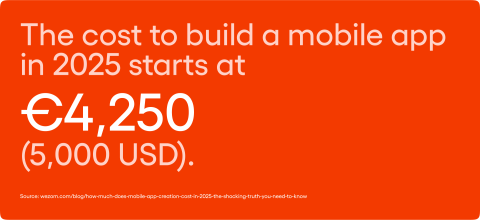
Medium-complexity applications
Step up to average complexity apps fall in this category—think of a fitness tracker or a small e-commerce platform. These need more: user logins, data storage, and maybe some integration with other systems. The mobile app development cost jumps from €42,500 to €102,000 (50,000 to 120,000 USD), reflecting the extra effort. Building them takes 4 to 6 months, with developers logging 800 to 1,600 hours of work. The complexity isn’t just in coding; testing and tweaking take time, too. For businesses wanting solid functionality without going overboard, this is where many app development projects land.
Complex applications
Now, picture something massive—an app like Uber or a banking platform. These complex apps are beasts, packed with features like real-time tracking, secure payment gateways, and heavy data storage. Costs soar from €102,000 to €255,000 (120,000 to 300,000 USD), though some estimates stretch from €17,000 to €425,000 (20,000 to 500,000 USD). The timeline? At least 9 months, often more. Why is it so pricey? The development team has to juggle advanced tech, security, and scalability—things that can’t be rushed. Big companies with deep pockets usually tackle these.
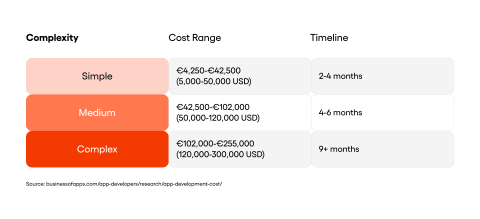
Development approaches and cost implications
How you build your app — whether native app development or cross-platform mobile app — flips the app development price upside down. Let’s dig into the options and what they mean for your wallet.
Native development (iOS and Android)
Want an app tailored for Google’s Android operating system or Apple’s iOS? That’s native app development. It’s top-notch but expensive because you’re building two separate apps. For a basic native mobile app development project, expect €76,500 to €148,750 (90,000 to 175,000 USD). A medium-complexity one climbs to €148,750 to €280,500 (175,000 to 330,000 USD), and complex mobile apps start at €280,500 (330,000 USD) and rocket upward. Why? Each platform needs its own code, design, and testing. It’s double the work, but the result is slick and fast—perfect for users who notice every detail. Plus, native apps fully leverage a device’s features, which is crucial for applications needing access to things like the camera, biometrics, or other hardware-specific capabilities. That seamless integration can make all the difference.
Cross-platform development
Rather build once and run everywhere? Cross-platform mobile app development saves time and money. Three big players dominate here: Flutter, Kotlin Multiplatform, and React Native.
Flutter
Using Flutter, a basic app costs €51,000 to €89,250 (60,000 to 105,000 USD). Medium-complexity apps range from €89,250 to €161,500 (105,000 to 190,000 USD), and complex apps begin at €161,500 (190,000 USD). Google’s toolkit lets developers write one codebase for both iOS and Android, slashing hours and costs. It’s not as custom as native but a solid middle ground.
Kotlin Multiplatform
Kotlin Multiplatform is another contender. A basic app sits at €59,500 to €106,250 (70,000 to 125,000 USD), medium ones at €106,250 to €195,500 (125,000 to 230,000 USD), and complex ones at €195,500 (230,000 USD) or more. It’s newer, flexible, and shares code across platforms, though it might need extra tweaks for peak performance. For budget-conscious projects, it’s a smart pick.
React Native
React Native, backed by Facebook, is a popular choice, too. A basic app ranges from €21,250 to €63,750 (25,000 to 75,000 USD), medium-complexity apps from €63,750 to €127,500 (75,000 to 150,000 USD), and complex apps start at €212,500 (250,000 USD) and climb higher. It uses JavaScript and shares code across iOS and Android, offering fast development with a native-like feel. Its vast community and libraries make it a go-to for many app development agencies.
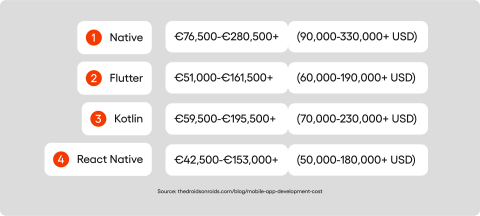
Cost breakdown by development stages
Building a mobile app isn’t just one big job — it’s a series of steps, each with its own slice of the budget. Knowing how the app development cost breakdown works helps you see where your money goes. Let’s walk through the stages and their costs, based on solid data from 2025.
Discovery/planning stage
Before a single line of code is written, there’s planning. This stage—where ideas turn into blueprints—takes 10-15% of your total app development budget. For a €42,500 (50,000 USD) app, that’s €4,250 to €6,375 (5,000-7,500 USD). Here, your app development team maps out features, sketches the mobile app design, and sets timelines. It’s not glamorous, but skipping it risks chaos later. A good plan keeps the development process on track.
Design stage
Next comes the look and feel — think screens, buttons, and flow. The mobile app design stage grabs 20-25% of the budget. For that same €42,500 (50,000 USD) app, you’re looking at €8,500 to €10,625 (10,000-12,500 USD). Designers craft the user experience (UX) and interface (UI), ensuring your app isn’t just functional but also a joy to use. For complex apps, this cost climbs as more screens and interactions pile up.
Development stage
Here’s the heavy lifting—coding the app itself. This chunk eats up 40-55% of the budget, so for €42,500 (50,000 USD), that’s €17,000 to €23,375 (20,000-27,500 USD). Developers bring features to life, whether it’s push notifications or data storage, and the time depends on the app’s complexity. A simple app might lean toward the lower end, while more complex apps push the upper limit. This is where your vision becomes real.
Testing and deployment stage
Before your app hits the app store, it needs testing—lots of it. Bugs get squashed, and performance gets polished. This takes 15-20% of the budget—€6,375 to €8,500 (7,500-10,000 USD) for our €42,500 (50,000 USD) example. Then, the deployment uploads it to Google Play or the App Store. Skimp here, and users will notice that quality matters.
Post-launch costs
The app’s live — job done? Not quite. App maintenance costs run 15-20% of the original development cost yearly. For a €42,500 (50,000 USD) app, that’s €6,375 to €8,500 (7,500-10,000 USD) annually. Updates, bug fixes, and server fees keep it running. Plus, marketing — think €4,250 to €42,500 (5,000-50,000 USD) per year—gets it noticed. These hidden app development costs can sneak up if you’re not prepared.
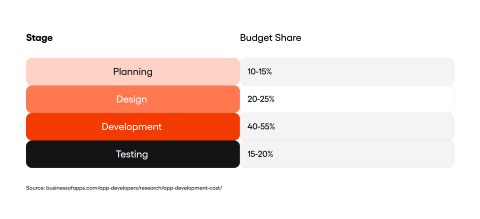
Geographic cost variations
Where your app development company is based changes everything. Developer rates differ globally, which ripples through the mobile app development cost. Let’s see how.
US and Western Europe
In the United States, hourly rates range from €96-€167 (113-196 USD). In Western Europe, expect €96-€144 (113-169 USD). Why the premium? These regions bring top-tier expertise, higher living costs, and the benefit of working with seasoned developers close to home.
Central and Eastern Europe
In Central and Eastern Europe, like Poland, hourly rates are €39-€68 (46-80 USD). This hits a cost-effective sweet spot—rates are much lower than in the West, yet tech hubs like Gdańsk offer strong talent. It’s where savings and quality align.
Asia
Across Asia, including India, hourly rates drop to €29-€48 (34-56 USD). It’s budget-friendly, but watch out—communication gaps or quality variations might arise. Picking the right partner is critical here.
Feature-specific cost analysis
Features are the heart of your app—and its price. Let’s break down some common ones and their impact on the development cost.
User authentication features
Want users to log in with Facebook or Google? Social media login takes 8-16 hours, costing €272 to €544 (320-640 USD) at €34 (40 USD) per hour. It’s quick and boosts user trust, a small price for a big win.
Communication features
Need chat or alerts? Messaging/chat runs 40-120 hours, or €1,360 to €4,080 (1,600-4,800 USD) at €34 (40 USD) per hour. Push notifications start at 40 hours, or €1,360 (1,600 USD) and up. These keep users engaged, but the hours add up fast.
Standard features development
A typical package—login, profiles, basic navigation—takes 300-700 hours, costing €12,750 to €29,750 (15,000-35,000 USD). This is the backbone of most simple apps, setting the initial app development cost.
AI and machine learning components
Fancy some AI? It spikes costs by 30-300% above the base—turning a €42,500 (50,000 USD) app into €55,250 to €170,000 (65,000-200,000 USD). Gartner predicts future tools could cut this by 40%—good news for tomorrow’s complex app project.
Real-world cost examples
Numbers are great, but real examples make the mobile app development cost crystal clear. Let’s look at ride-sharing industry to see how costs play out in 2025.
Ride-sharing/on-demand services (Uber-like)
Dreaming of the next Uber? A ride-sharing app for both iOS app development and Android app development ranges from €323,000 to €450,500 (380,000 to 530,000 USD)—and that’s just the MVP (minimum viable product). The timeline? 5-7 months for a basic version. Real-time tracking, payment gateways, and driver-user matching push costs sky-high. These apps thrive on scale, but the initial app development cost reflects the tech needed to get started.
Team composition impact on cost
Who builds your app matters as much as what they build. The development team — their size, skills, and roles — shapes the app development budget.
Standard team composition
A typical app development team has 6-8 specialists: developers, designers, testers, and a project manager. Costs range from €34,000 to €127,500 (40,000 to 150,000 USD), depending on the project’s scope and location. More hands mean faster work, but also a bigger bill.

Specialized roles and their cost impact
Take a complex project example. A team with two iOS developers, two Android developers, a designer, a tester, and a manager—seven people—might cost €127,500 (150,000 USD) for a mid-range app. Specialized roles—like dual-platform coders—add precision but also expense. For complex mobile apps, niche skills aren’t optional; they’re essential.
Cost optimization strategies
Worried about the price? You can trim the mobile app cost without cutting quality. Here’s how.
MVP approach benefits
Start small with a minimum viable product (MVP). Launch with basic features, test the market, and then add more later. This slashes the initial app development cost—a €42,500 (50,000 USD) app might drop to €17,000 (20,000 USD)—and lets you adjust based on user feedback. It’s lean and smart.
Technology stack selection
Pick the right development tools. Cross-platform mobile app frameworks like Flutter or React Native cut costs compared to native app development. Choosing open-source tools over pricey licensed ones also helps. The stack affects both speed and price—choose wisely.
Outsourcing vs. in-house development analysis
Hiring developers in-house gives control but hikes costs—think salaries, benefits, and office space. App development outsourcing to Eastern Europe or Asia can halve rates, dropping from €85 (100 USD) per hour in the US to €34 (40 USD) or less elsewhere. The trade-off? Time zones and communication. Weigh your priorities.
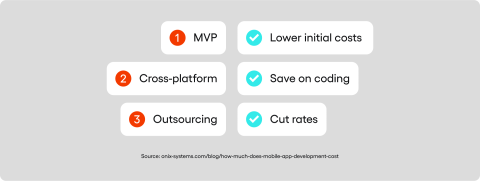
Conclusion and planning recommendations
What’s the cost of making a mobile app in 2025? It depends. Simple apps start at €4,250 (5,000 USD)—these are basic apps with just a few features. Complex apps with lots of extras can cost €212,500 (250,000 USD) or more. But that’s not the whole story. Building the app is just the start. After launching, you’ll spend 15-20% of the original cost each year to keep it running. You’ll also need money for marketing to get noticed and for changes based on what users say or what the market needs. To plan well, add a bit extra to your budget for surprises. Start with a simple app (an MVP) to test it out. Pick a company that fits your ideas, skills, and budget. Costs depend on how tricky the app is, where the team works, and new tech like AI. Success comes from smart planning, not just the cheapest price.
FAQ Section
What is the average cost to build a mobile app in 2025?
The cost to build a mobile app varies widely, but in 2025, it averages between €4,250 to €212,500 (5,000 to 250,000 USD). Simple apps like calculators might hit the low end, while complex mobile apps like Uber climb higher. The app development cost depends on features, team location, and tech choices—think native app versus hybrid apps — factor in app maintenance costs, too, which add 15-20% yearly. Use app development cost calculators to get a rough idea, but real quotes from app developers nail it down.
How much does app maintenance cost after launch?
App maintenance isn’t optional—it keeps your mobile app running smoothly. Expect 15-20% of the development cost annually, so a €42,500 (50,000 USD) app means €6,375 to €8,500 (7,500-10,000 USD) each year. This covers updates, bug fixes, and server fees. Complex apps with data storage or push notifications might lean higher, while simple apps stay lower. Don’t forget ongoing maintenance—it’s key to your app’s success.
What factors affect mobile app development costs?
The mobile app development cost hinges on several things. First, the app’s complexity—basic features cost less than payment gateways or AI. Second, the development process: native app development for iOS and Android apps doubles effort versus cross-platform mobile app options. Finally, extras like mobile app design or marketing add up. Every choice shapes the app cost.
How long does the mobile app development process take?
The mobile app development process varies by complexity. Simple apps take 2-4 months, medium ones 4-6 months, and complex apps 9+ months. A development team coding an iOS app and an Android app separately stretches timelines, while cross-platform mobile app tools like Flutter speed things up. Planning and testing — part of every app development stage — also add weeks. Tight deadlines? An MVP cuts time.
What’s the difference between native and hybrid apps in cost?
Native apps—built for one platform like Google’s Android operating system—cost more: €76,500 to €280,500 (90,000-330,000 USD) for basic to complex. Hybrid apps, or cross-platform mobile app projects, use one codebase, dropping to €42,500 to €195,500 (50,000-230,000 USD) with tools like React Native or Flutter. Native mobile app developer work shines in performance, but app development agencies love hybrid apps for budget-friendly speed. Your app development budget decides.
Are there hidden app development costs to watch for?
Yes, hidden app development costs can sting. Beyond the initial app development cost, app maintenance costs hit 15-20% yearly. Marketing—€4,250 to €42,500 (5,000-50,000 USD)—gets your app seen. Server fees, data storage, or unexpected fixes also creep in. Poor planning or scope creep during the development process adds more. Budget for these to avoid shocks.
What’s the cost of adding push notifications to an app?
Push notifications cost €1,360 (1,600 USD) and up, based on 40+ hours at €34 (40 USD) per hour. Simple alerts are quick, but tying them to data storage or user actions bumps hours. They’re vital for engagement, so most mobile app developers recommend them despite the app development price tick.
Why do complex apps cost so much more?
Complex apps like banking or ride-sharing apps cost €102,000 to €425,000 (120,000-500,000 USD) because they pack advanced tech—payment gateways, real-time data, and security. The development team needs more time (9+ months) and skills, driving up the app cost. Testing and app maintenance also soar. Complexity equals investment.
How can I reduce my app development budget?
To cut your app development budget, try an MVP—launch with basic features for €17,000 (20,000 USD) instead of €42,500 (50,000 USD). Use cross-platform mobile app tools like React Native to save on coding. App development outsourcing to cheaper regions helps, too. Skip pricey extras like AI unless vital. Smart planning keeps development costs low and your app’s success high. It is also worth not skipping the analytical phase, which will allow for accurate specification of requirements and reduce the cost of unforeseen changes.
This blog post was created by our team of experts specialising in AI Governance, Web Development, Mobile Development, Technical Consultancy, and Digital Product Design. Our goal is to provide educational value and insights without marketing intent.


